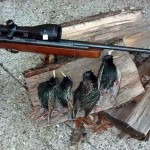This airgun article on hunting pests with spring powered air rifles was written by Randy Mitchell. The author of the following review is in no way affiliated with Airgun Depot. The views expressed below are personal opinion only.
Air
Rifles are bought for a variety of reasons. Many folks want to punch
holes in paper, others want to hunt small game with
an airgun. There are Olympic competitions that many
aspire to, and I would lay good money down that many firearms enthusiasts got
their start with an airgun. But sooner or later, either
the actual owner of the airgun, or perhaps their spouse,
is going to demand that the air rifle be put to a
very useful purpose….pest control.
What Are Pests?
Now a pest can come in many disguises. Among the more acknowledged
pests are certain birds, such as the European starling and the English sparrow.
Rodents such as mice and rats are also almost universally considered pests.
Pigeons, fed in many city parks by well-intentioned individuals, create an incredible
mess on rooftops and sidewalks, and seem to take a particular delight is decorating
the clean exteriors of cars with their droppings.
Why Use A Spring Piston Airgun For Pest Control?
Using a spring-piston air rifle
for pest control makes a lot of sense for several reasons. First, it is a self-contained
power plant, needing only to be cocked and loaded. You don’t have to insert
a CO2 cartridge or place air in a reservoir in order to use it. Secondly, the
design of the spring-piston airgun is robust, giving
you good performance under a plethora of conditions…..warm weather, cold weather,
rain or shine….it is going to work. Third, there are so many different kinds
of spring-piston air rifles available that you can
find one to fit your budget and shooting requirements.
Spring Piston Basics
If you are new to spring-piston airguns,
here are a few things you need to know to make your shooting experience more
enjoyable. Keeping safety in mind, let’s cock and load the most common design
in spring-piston air rifles, the break-barrel. This
gun is cocked by giving the barrel a rap near the muzzle, breaking open the
action of the gun.
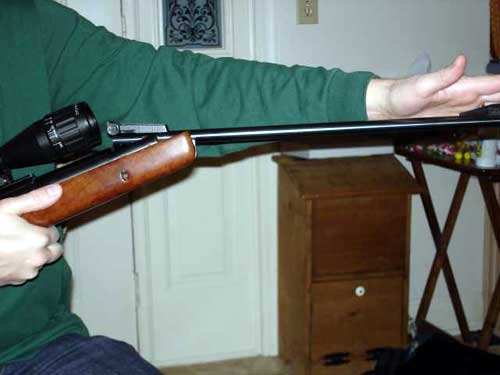
Grab the barrel and bend it down until the gun cocks. Now
here is where some people make a mistake. Don’t let go of the barrel …..if the action snaps shut unexpectedly, you run the risk of
damaging the airgun as well as causing personal injury
to yourself. Many airgun designs incorporate a “bear trap”
feature to protect against that, but you are placing your faith in a mechanical
device that will, one day, fail. Get in the habit of retaining your hold on
the barrel and using the other hand to load the pellet, seating it firmly in
place.
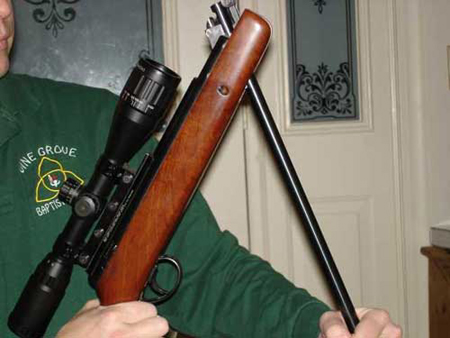
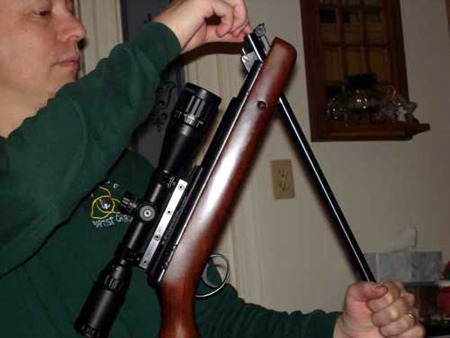
Don’t Let go of the barrel when loading
Then close the barrel while pointing the airgun
in a safe direction. Once your spring-piston air rifle
is cocked, you need to shoot it within a reasonable amount of time. Leaving
the gun cocked for extended periods of time will eventually cause the spring
to take a set, reducing the effectiveness and longevity of the airgun.
Some break-barrel designs allow you to uncock the gun, but many don’t.
You will have to discharge the pellet by firing the gun in a safe direction
if your pest doesn’t hang around long enough for you to take a shot.
Shooting Technique- It’s not the same as a centerfire rifle.
Shooting spring-piston air rifles
can be a learning experience all in itself. I have found that holding the gun
as lightly as possible works well, and being consistent in the placement of
my hand on the forearm helps ensure good groups on target. Firearm shooters
who buy a spring-piston airgun often have to unlearn the habits they picked up firing centerfire rifles. Shooting springers
is almost the opposite of shooting large caliber firearms. Experiment with your
hold on the forearm to see where the gun likes to be held. This may seem odd,
but you will often find there is a “sweet spot” where the gun shoots
the best. Refrain from resting the forearm or barrel on a hard, unyielding
surface. The bounce from the recoil will wreak havoc with your accuracy.
I get good results by simply making a shelf out of my hand and laying the gun
across it, not actually holding the forearm. I can also be more consistent this
way, which helps in my accuracy.
Pest Control Basics
If you will take a look at the hunting laws and regulations
in many states, you will find that there is a year-round, no-limit rule for
animals designated as pests, allowing the airgunner
to enjoy the legal, and encouraged, culling of pests. It is a great way to hone
your hunting skills, and allows the avid hunter to enjoy an off-season use for
his sport that also benefits the local environment by reducing the competition
that pests put upon more desirable species. For instance, many kinds of birds
are cavity dwellers….among them the bluebird, woodpecker, and purple martins.
The European starling is a huge competitor for nesting sights,
and has the assets that nature has provided to evict the afore-mentioned birds
from their nests. With a dagger-like beak and a much heavier build, the starling
can and will kill the other birds in their nests, taking over the nesting cavity
for its own use. English sparrows are just as deadly to our indigenous bird
population. In my back yard, just last year, I witnessed the death of a family
of bluebirds at the hands of English sparrows, which subsequently built a nest
over the top of the murdered young bluebirds. See the picture below as evidence.
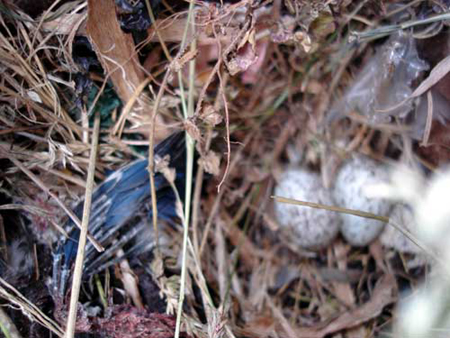
English Sparrow nest built on top of family of blue
birds
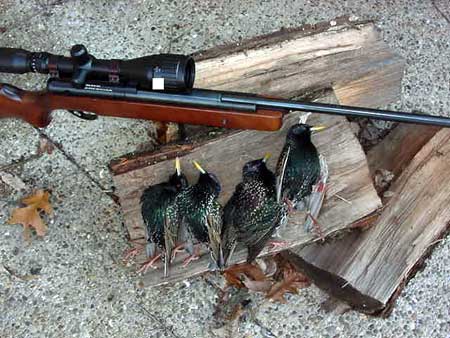
Payback- 4 Less European Starlings=more bluebirds, woodpeckers etc.
Not all pests are avian. Rats and mice carry disease, and dwell
in close proximity to man and man-made dwellings, flourishing nicely off of
our refuse. And in some parts of the country, groundhogs and their relatives
cause foundation damage by hollowing out the ground underneath support beams
and concrete slabs. In Louisiana, my home state, the nutria rat has to be culled
by the police department around New Orleans due to their habit of burrowing
into the levies that keep the water at bay. Louisiana has even posted a bounty
on the pest in an effort to encourage the reduction in the population of this animal
whose behavior can have catastrophic results.
In addition to these acknowledged pests, there are instances
where game animals become pests. If you are lucky, you may reside in a state
that has hunting rules that allow one to shoot game animals out of season in
the event their behavior becomes damaging to crops or property. For instance,
crows may be harvested year-round in some states if they are in the act of crop
depredation, even though there is a dedicated season for the general hunting of
corvids. When squirrels moved into my attic, I called the
department of wildlife in my state of residence and was told to just shoot
them. The wise thing to do when you have a game animal becoming a pest is to
check with your state and local authorities to keep yourself out of trouble.
Offer Your Pest Control Services
Airgunners can often engender good
will by offering their services free of charge to landowners, ranchers, and
farmers. Both parties benefit from such an arrangement, the land owner getting
pest control for free, and the airgunner securing
another shooting venue. I know several airgunners
who have a standing invitation to control pests at several different locations.
When the hunting season is over, they head for these spots to continue honing
their skills by culling pests. There are even individuals who do pest control
as a job, coupling their hobby of airguns with a pest
control business.
Now I enjoy shooting pests, as I try and give all my desirable
bird species a leg up over their competitors. English sparrows and European
starlings fall with regularity to my airguns. I actually
spend about half an hour each morning as weather permits waiting for starlings
to roost in the front yard tree. Shooting from the porch, I discourage them
from nesting in the hollows of the tree. I try very hard to reserve those hollows
for bluebirds and woodpeckers. I also spend many enjoyable moments observing
my bird feeders, and when the English sparrows come calling, their bodies start
falling. Squirrels that start looking around the eaves of my house for potential
nesting locations are quickly dealt with. Occasionally, a groundhog will take
up residence under the old barn on my property, and out comes a suitably powerful
airgun to deal with the unwanted pest.
Check Your Laws & Educate Your Neighbors
When you are engaged in controlling pests, you often are in
a residential area. In light of this fact, let me share a few words of caution.
Check your local ordinances to ensure you are shooting legally. Also, consider
the attitudes and prejudices of your neighbors. There are very few pests that
are worth gaining the enmity of those with whom you
interact on a daily basis. I talk with and personally know the head of my local
law enforcement department, and as an avid hunter himself, he has shown an interest
in my airguns and their uses. All my neighbors know
of my airgun hobby, and don’t get alarmed when they
see me in the yard with what appears to be a scoped rifle. Be sure of your backstop,
always knowing where your pellet will go if you miss. And never, ever shoot
a domestic animal that is merely trespassing. It isn’t the animal’s fault, it is the fault of the owner. Go and talk with them
in a reasonable manner. If that doesn’t achieve the desired results, contact
your local animal control officer. Let them deal with the owner of the offending
animal. They have the law on their side and will save you much heartache if
you let them do their job before resorting to handling the situation yourself.
In a perfect world, everyone would recognize the need to control
pests. However, you will run across individuals who will ask why you are shooting
the pretty black birds (starlings), or the cute little sparrows (English sparrows).
Knowing more about your pest and being able to speak with authority about their
habits go a long way in convincing those who object to your pest control methods.
Explain to the well-intentioned objector that starlings and sparrows (the latter
a member of the weaver-bird family and not a true sparrow) were introduced into
the United States over a century ago,
and that they have spread in almost plague-like proportions, competing with
our own songbirds and other indigenous bird life for food and nesting sites.
They cause millions of dollars in damage to our agriculture each year, consuming
or fouling grain-based foods for the livestock industry, contributing to the
spread of histoplasmosis and other diseases, and causing unsightly messes
with their nest building habits. Municipalities yearly spend millions of valuable
tax dollars trying to cope with the large winter flocks of starlings. Remind
them that the next time they are at the grocery store, they should look up at
the eaves of the building, or over the entrance of the door and see if they
don’t spy an untidy bird nest nestled right over the path they are walking.
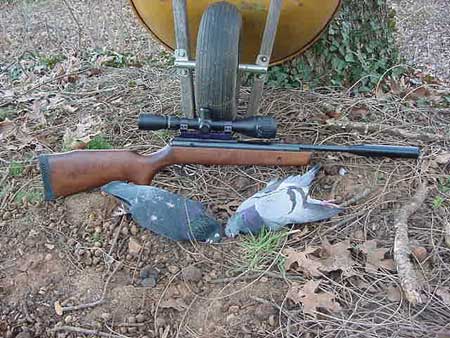
Pigeons- Another messy pest
Baiting Pests
From time to time you will find a pest situation that calls
for the baiting of the pest in order to eliminate it. Rats are among those pests
that are susceptible to being baited out in the open in order to cull their
numbers. Nocturnal shoots work best with rats, and baits consisting of peanut
butter and other very smelly baits will draw them out into the open allowing
the airgunner an opportunity to deal with their unwanted
presence. In many pest control situations, over penetration is not desired.
Consider using wadcutter pellets, or perhaps hollow
points in order to limit over-penetration. Another way to control the results
of a missed shot is to build a backstop and place
your baits in front of it. I have even seen plans on the internet of a glow-in-the-dark
backstop that outlined the pest as they stepped in front of it! There are countless
variations on ways to use subdued lighting, baits, and backstops to accomplish
the goal of pest control….so use your imagination and enjoy your hobby of airgunning.
Airguns Are Safer Than Using Poisons
The use of air rifles to cull pests is more precise, as well as more environmentally
safe, than using poisons that have been developed for the pest control industry.
Many of the poisons used to control avians have a
nasty tendency to pass from the target pest into the surrounding environment.
In other words, if you poison a starling or pigeon, it will fly off and die
somewhere other than the poison site, and a scavenger that picks it up and eats
it may perish from the same poison. This puts at risk your dog and cat, raccoons,
foxes, birds of prey as well as vultures, and many other animals that eat carrion.
When you use an airgun, you can pick up after yourself and dispose of the
pest in a safe manner.
Which Caliber Should I Use?
The size of a pest will help you determine which caliber of
airgun to use. Sparrows and starlings rarely need anything
more powerful than a medium-powered .177. Pigeons and crows are tougher, and
I like to use a .22 caliber hunting air
rifle on these pests. Rats and mice all fall to the tiny .177 just
fine, though you will run across some rats that may make you wish you had a
.22. Groundhogs and nutria are pushing the upper limit in the size of most common
pests, and I recommend a .22 caliber or larger airgun for these
larger animals. Remember our discussion earlier about backstop issues and plan
accordingly so that your use of an airgun for pest
control becomes a positive event and not a negative liability.
In short, let your hobby and enjoyment of airguns be put to the very useful purpose of pest control
when the need arises. And if you hunt, let it be an additional training ground
for when you go out in pursuit of game animals. Have fun, and shoot safely.
